
AIPMT 2012 Exam Syllabus
BIOLOGY (BOTANY AND ZOOLOGY)
Unit : 1 Diversity in Living World
Biology – its meaning and relevance to mankind What is living; Taxonomic
categories and aids (Botanical gardens, herbaria, museums, zoological parks);
Systematics and Binomial system of nomenclature. Introductory classification of
living organisms (Two-kingdom system, Five-kingdom system); Major groups of each
kingdom alongwith their salient features (Monera, including Archaebacteria and
Cyanobacteria, Protista, Fungi, Plantae, Animalia); Viruses; Lichens Plant
kingdom – Salient features of major groups (Algae to Angiosperms); Animal
kingdom – Salient features of Nonchordates up to phylum, and Chordates up to
class level.
Unit : 2 Cell : The Unit of Life ; Structure and Function
Cell wall; Cell membrane; Endomembrane system (ER, Golgi apparatus/Dictyosome,
Lysosomes, Vacuoles); Mitochondria; Plastids; Ribosomes; Cytoskeleton; Cilia and
Flagella; Centrosome and Centriole; Nucleus; Microbodies. Structural differences
between prokaryotic and eukaryotic, and between plant and animal cells. Cell
cycle (various phases); Mitosis; Meiosis. Biomolecules – Structure and function
of Carbohydrates, Proteins, Lipids, and Nucleic acids. Enzymes – Chemical
nature, types, properties and mechanism of action.
Unit : 3 Genetics and Evolution
Mendelian inheritance; Chromosome theory of inheritance; Gene interaction;
Incomplete dominance; Co-dominance; Complementary genes; Multiple alleles;
Linkage and Crossing over; Inheritance patterns of hemophilia and blood groups
in humans. DNA –its organization and replication; Transcription and Translation;
Gene expression and regulation; DNA fingerprinting. Theories and evidences of
evolution, including modern Darwinism.
Unit : 4 Structure and Function – Plants
Morphology of a flowering plant; Tissues and tissue systems in plants;
Anatomy and function of root, stem(including modifications), leaf,
inflorescence, flower (including position and arrangement of different whorls,
placentation), fruit and seed; Types of fruit; Secondary growth; Absorption and
movement of water (including diffusion, osmosis and water relations of cell) and
of nutrients; Translocation of food; Transpiration and gaseous exchange;
Mechanism of stomatal movement. Mineral nutrition – Macro- and micro-nutrients
in plants including deficiency disorders; Biological nitrogen fixation
mechanism. Photosynthesis – Light reaction, cyclic and non- yclic
photophosphorylation; Various pathways of carbon dioxide fixation;
Photorespiration; Limiting factors . Respiration – Anaerobic, Fermentation,
Aerobic; Glycolysis, TCA cycle; Electron transport system; Energy relations.

















